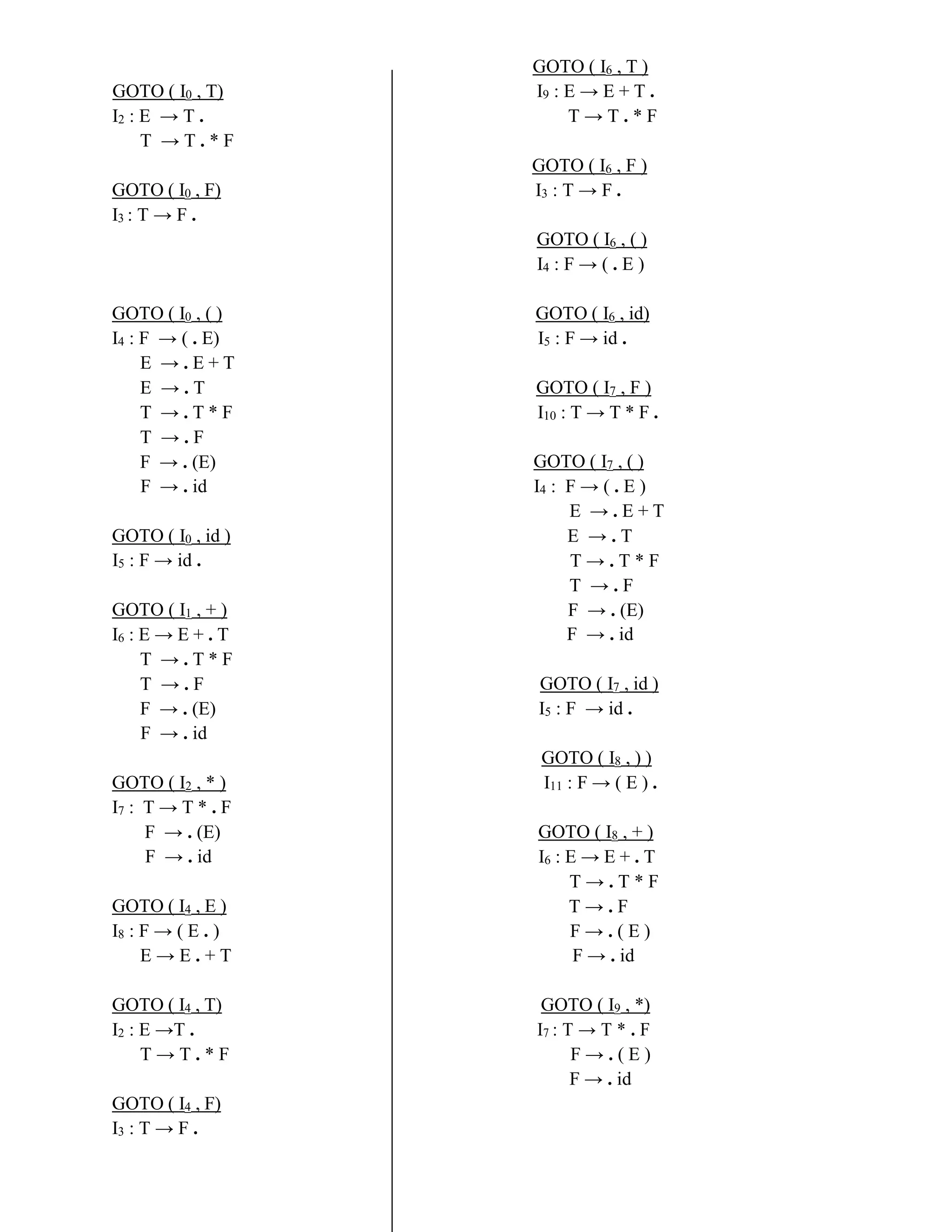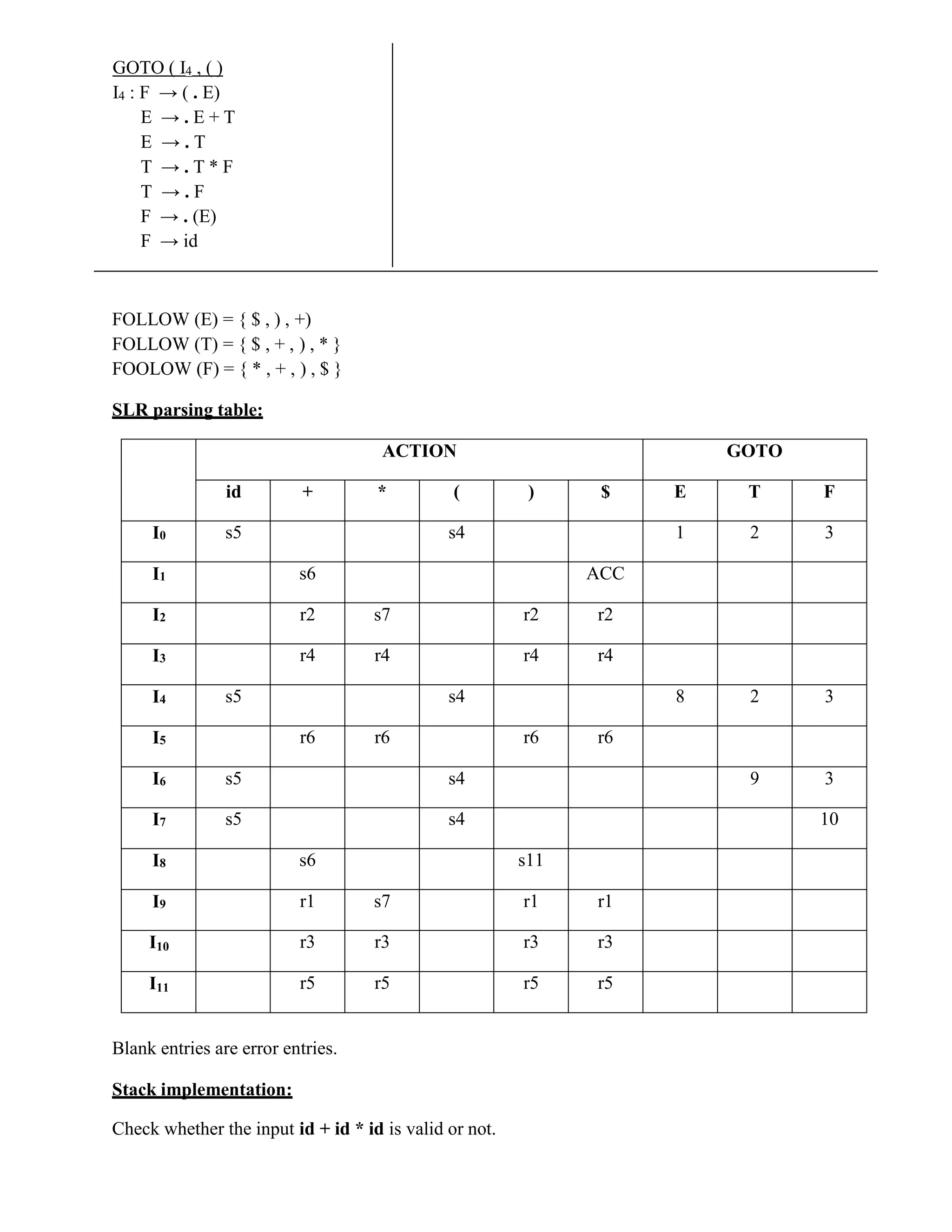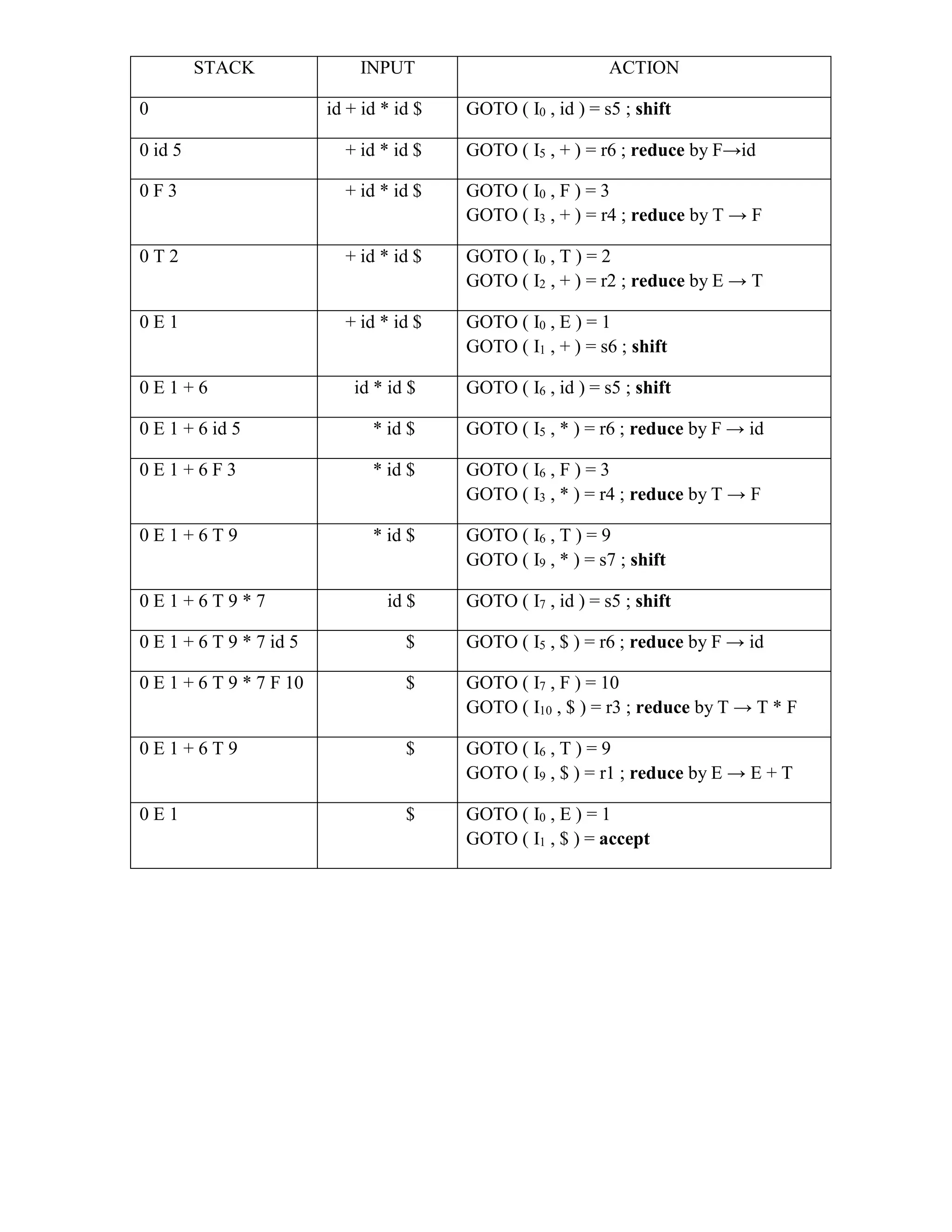The document discusses LR parsers, which are bottom-up parsing techniques used to parse context-free grammars. LR parsers work by shifting and reducing based on the entries in an LR parsing table. The table is constructed from LR(0) items generated from the grammar. The document provides details on the construction of the SLR parsing table and gives an example of using an SLR parser to check if an input is valid according to a grammar.

![It consists of : an input, an output, a stack, a driver program, and a parsing table that has two
parts (action and goto).
The driver program is the same for all LR parser.
The parsing program reads characters from an input buffer one at a time.
The program uses a stack to store a string of the form s0X1s1X2s2…Xmsm, where sm is on
top. Each Xi is a grammar symbol and each si is a state.
The parsing table consists of two parts : action and goto functions.
Action : The parsing program determines sm, the state currently on top of stack, and ai, the
current input symbol. It then consults action[sm,ai] in the action table which can have one of four
values :
1. shift s, where s is a state,
2. reduce by a grammar production A → β,
3. accept, and
4. error.
Goto : The function goto takes a state and grammar symbol as arguments and produces a state.
LR Parsing algorithm:
Input: An input string w and an LR parsing table with functions action and goto for grammar G.
Output: If w is in L(G), a bottom-up-parse for w; otherwise, an error indication.
Method: Initially, the parser has s0 on its stack, where s0 is the initial state, and w$ in the input
buffer. The parser then executes the following program :
set ip to point to the first input symbol of w$;
repeat forever begin
let s be the state on top of the stack and
a the symbol pointed to by ip;
if action[s, a] = shift s’ then begin
push a then s’ on top of the stack;
advance ip to the next input symbol
end
else if action[s, a] = reduce A→β then begin
pop 2* | β | symbols off the stack;
let s’ be the state now on top of the stack;
push A then goto[s’, A] on top of the stack;
output the production A→ β
end
else if action[s, a] = accept then
return
else error( )
end](https://image.slidesharecdn.com/11-slrinputstringparsingclrintroduction-06-06-2023-230707153611-e47cfae8/75/11-SLR-input-string-parsing-CLR-introduction-06-06-2023-docx-2-2048.jpg)
![CONSTRUCTING SLR(1) PARSING TABLE:
To perform SLR parsing, take grammar as input and do the following:
1. Find LR(0) items.
2. Completing the closure.
3. Compute goto(I,X), where, I is set of items and X is grammar symbol.
LR(0) items:
An LR(0) item of a grammar G is a production of G with a dot at some position of the
right side. For example, production A → XYZ yields the four items :
A → . XYZ
A → X . YZ
A → XY . Z
A → XYZ .
Closure operation:
If I is a set of items for a grammar G, then closure(I) is the set of items constructed from I
by the two rules:
1. Initially, every item in I is added to closure(I).
2. If A → α . Bβ is in closure(I) and B → γ is a production, then add the item B → . γ to I , if it
is not already there. We apply this rule until no more new items can be added to closure(I).
Goto operation:
Goto(I, X) is defined to be the closure of the set of all items [A→ αX . β] such that
[A→ α . Xβ] is in I.
Steps to construct SLR parsing table for grammar G are:
1. Augment G and produce G’
2. Construct the canonical collection of set of items C for G’
3. Construct the parsing action function action and goto using the following algorithm that
requires FOLLOW(A) for each non-terminal of grammar.
Algorithm for construction of SLR parsing table:
Input : An augmented grammar G’
Output : The SLR parsing table functions action and goto for G’
Method :
1. Construct C = {I0, I1, …. In}, the collection of sets of LR(0) items for G’.
2. State i is constructed from Ii.. The parsing functions for state i are determined as follows:
(a) If [A→α∙aβ] is in Ii and goto(Ii,a) = Ij, then set action[i,a] to “shift j”. Here a must be
terminal.
(b) If [A→α∙] is in Ii , then set action[i,a] to “reduce A→α” for all a in FOLLOW(A).
(c) If [S’→S.] is in Ii, then set action[i,$] to “accept”.
If any conflicting actions are generated by the above rules, we say grammar is not SLR(1).](https://image.slidesharecdn.com/11-slrinputstringparsingclrintroduction-06-06-2023-230707153611-e47cfae8/75/11-SLR-input-string-parsing-CLR-introduction-06-06-2023-docx-3-2048.jpg)
![3. The goto transitions for state i are constructed for all non-terminals A using the rule:
If goto(Ii,A) = Ij, then goto[i,A] = j.
4. All entries not defined by rules (2) and (3) are made “error”
5. The initial state of the parser is the one constructed from the set of items containing
[S’→.S].
Example for SLR parsing:
Construct SLR parsing for the following grammar :
G : E → E + T | T
T → T * F | F
F → (E) | id
The given grammar is :
G : E → E + T ------ (1)
E →T ------ (2)
T → T * F ------ (3)
T → F ------ (4)
F → (E) ------ (5)
F → id ------ (6)
Step 1 : Convert given grammar into augmented grammar.
Augmented grammar :
E’ → E
E → E + T
E → T
T → T * F
T → F
F → (E)
F → id
Step 2 : Find LR (0) items.
I0 : E’ → . E
E → . E + T
E → . T
T → . T * F
T → . F
F → . (E)
F → . id
GOTO ( I0 , E)
I1 : E’ → E .
E → E . + T
GOTO ( I4 , id )
I5 : F → id .](https://image.slidesharecdn.com/11-slrinputstringparsingclrintroduction-06-06-2023-230707153611-e47cfae8/75/11-SLR-input-string-parsing-CLR-introduction-06-06-2023-docx-4-2048.jpg)


